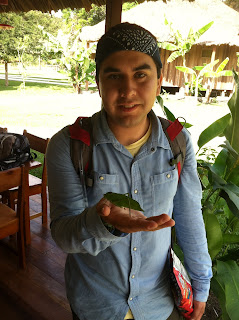KRISTI: Good morning! The class is moving from La Milpa Station this morning to the Tropical Education Center across from the Belize Zoo. They’ll be doing a community service project at the Zoo and then going on a night Zoo tour. Here are some interviews from yesterday at La Milpa:
MELVIS (Our bird guide at La Milpa): It’s a great pleasure and honor to have [the NMSU class] here…and hopefully they come back to do the program at least once more. (Several students in the background responded – “oh, we’re coming back”). I think this is a very educational program for the students especially…it takes them a long way and gives them a great opportunity to learn more about that Belizean subtropical rainforest. For the Belize students [on this course], it’s really really great because these are the very first people that we want to involve in protected areas and conservation. In primary and secondary schools here, they are not teaching this kind of stuff and you only get this from 12th grade on so it’s a very small window for these students to go and explore and find out what they have in their own backyard and country. Hopefully they retain what they learn and appreciate what they have in this country.
DACHIN: The highlight of my trip so far – it’s hard to say because we’ve seen so much - but climbing to the top of the Maya temple today was pretty amazing. Even riding on the river boat today…with seeing all the birds….I don’t know it just felt…like a liberating experience…wind through hair, beautiful birds...
Last night we went out on a night drive and saw a male crested guan roosting in the tree; a possum too. On the away back we spotted a kinkajou – he was climbing around in the canopy. We were able to watch him for 20 minutes...that was pretty exciting. We went right up to La Milpa ruins and we turned out all the lights and sat in silence listening to the rainforest. It was pretty surreal experience just listening to the rainforest.
(Note: as Kristi is typing this interview with Dachin during dinner, Heather tried to catch a Mexican tree frog from the porch; the frog landed on Danny V’s plate in his ranch dressing. At the same time, Ariane was pouring juice when the top popped off – juice spilling all over her and her food. Not pleasant, she said, but she did admit it made her chicken a little more ‘juicy’.)
JULIE: (just coming back from a vegetation survey) So, what we've just been doing on the veg transects: You have a starting point; you walk 25 meters and you divide into 4 quadrants; you take the closest tree that’s over 16 centimeters; take the distance from center, measure the diameter, measure canopy cover.
This experience has been awesome. Love the food, animals, Maya ruins. The only thing I’ve seen so far that I hate is the giant cockroach (laughing). I’ve also held a scorpion which is amazing for me because I’m terrified of bugs. I climbed to the top of Lamanai ruin – which was pretty scary – but I’m facing my fears (big smile).
MARTHA: Everyone seems to be having a good time…they are really into working on their projects and capturing birds using mist nets and doing vegetation surveys looking for diversity and abundance of species. On our bird list so far, we have over 100 species in 3 ½ days. The tree group is having a tough time, the forest is pretty dense with so many vines and it’s hard to ID trees so it’s a real challenge. The mammal group set out 10 camera traps and will check the results of those cameras the last morning and hopefully catch some footage of diurnal cats, peccaries, opposums, coatimundis, kinkajous, tapirs...

Julie holding a bird at La Milpa

Corrie and Catherine

Melvis, La Milpa guide

Cool!

Shae, setting up a camera trap in the tropical forest near La Milpa station

Dr. Martha Desmond holding a hummingbird while students record photos and measurement data

Jayce, Corrie and (jamming) Heberto!

Dachin and Lori measure and record a captured bird for their research project at La Milpa
 For the past 6 years, I am so proud of what the Belize Field School (along with NMSU Study Abroad) has been doing for field education and service learning (for NMSU students and faculty) and community assistance, collaboration and conservation in Belize! Thank you to everyone who helped make this possible!
For the past 6 years, I am so proud of what the Belize Field School (along with NMSU Study Abroad) has been doing for field education and service learning (for NMSU students and faculty) and community assistance, collaboration and conservation in Belize! Thank you to everyone who helped make this possible!





















































